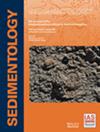Radiocarbon ages of microcrystalline authigenic carbonate in Lake Neusiedl (Austria) suggest millennial-scale growth of Mg-calcite and protodolomite
IF 2.8
2区 地球科学
Q1 GEOLOGY
引用次数: 0
Abstract
Authigenic Mg-calcite and dolomite are frequently observed in restricted, evaporative environments, such as lagoon or lake systems, but their formation is difficult to capture due to slow growth rates. Lake Neusiedl, an alkaline and subhaline lake with a mean water depth of 0.7 m in Austria, offers a natural system to study the precipitation of Ca-Mg-carbonate phases, which occur as fine-grained, unconsolidated and largely homogenized mud. To elucidate the timing and formation mechanisms of these authigenic carbonate phases, the mineralogical and isotopic composition and radiocarbon age of different sediment grain-size fractions from <0.2 to >3.0 μm were analysed. X-ray diffraction analyses show two broad peaks of Mg-calcite and protodolomite (lacking ordering peaks), suggesting that the carbonates are authigenic rather than detrital in origin. Calibrated carbon-14 ages range between 200 cal yr BP and 3700 cal yr BP. The linear correlation of age and grain size suggests a very slow growth rate of single crystals of 0.23 to 0.60 μm/ka. These rates suggest an extremely slow sedimentation rate in a shallow lake that existed during most of the Holocene. The higher abundance of protodolomite in older grain fractions, in contrast to the presence of high-Mg calcite in the youngest fractions, suggests a growth succession where high-Mg calcite develops first and subsequently transforms into protodolomite. Much higher ages of 6 cal ka BP to 15 cal ka BP are measured in carbonates of lake deposits exposed on land, in a section northwest of the recent lake, suggesting a growth rate of those carbonate minerals of 0.13 μm/ka. These time constraints further suggest that some carbonate grains could already have nucleated from lake water before or during the last glacial maximum, although under slightly different hydrochemical conditions.奥地利Neusiedl湖微晶自生碳酸盐的放射性碳年龄表明镁方解石和原白云岩在千年尺度上生长
自生镁方解石和白云石经常在有限的蒸发环境中观察到,如泻湖或湖泊系统,但由于生长速度缓慢,它们的形成很难捕捉。Neusiedl湖位于奥地利境内,平均水深0.7 m,为研究ca - mg -碳酸盐岩相的沉淀提供了一个自然系统,ca - mg -碳酸盐岩相以细粒、松散、均质化的泥浆形式存在。为了阐明这些自生碳酸盐相的形成时间和形成机制,分析了<0.2 ~ >3.0 μm不同沉积物粒度组分的矿物学、同位素组成和放射性碳年龄。x射线衍射分析显示镁方解石和原白云岩有两个宽峰(无序峰),表明碳酸盐为自生而非碎屑成因。校正后的碳14年龄范围在200至3700 cal - year BP之间。年龄与晶粒尺寸的线性关系表明单晶生长速率非常缓慢,为0.23 ~ 0.60 μm/ka。这些速率表明,在全新世的大部分时间里,一个浅湖的沉积速率极其缓慢。在较老的颗粒组分中原白云石的丰度较高,而在较年轻的颗粒组分中则存在高镁方解石,这表明了一个生长演替过程,即高镁方解石首先发育,随后转化为原白云石。在新近形成的湖泊西北剖面上,裸露在陆地上的湖泊沉积物碳酸盐的年龄在6 ~ 15 cal ka BP之间,表明这些碳酸盐矿物的生长速率为0.13 μm/ka。这些时间限制进一步表明,在末次极大期之前或期间,一些碳酸盐颗粒可能已经从湖水中成核,尽管水化学条件略有不同。
本文章由计算机程序翻译,如有差异,请以英文原文为准。
求助全文
约1分钟内获得全文
求助全文
来源期刊

Sedimentology
地学-地质学
CiteScore
8.20
自引率
11.40%
发文量
94
审稿时长
6-12 weeks
期刊介绍:
The international leader in its field, Sedimentology publishes ground-breaking research from across the spectrum of sedimentology, sedimentary geology and sedimentary geochemistry.
Areas covered include: experimental and theoretical grain transport; sediment fluxes; modern and ancient sedimentary environments; sequence stratigraphy sediment-organism interaction; palaeosoils; diagenesis; stable isotope geochemistry; environmental sedimentology
 求助内容:
求助内容: 应助结果提醒方式:
应助结果提醒方式:


